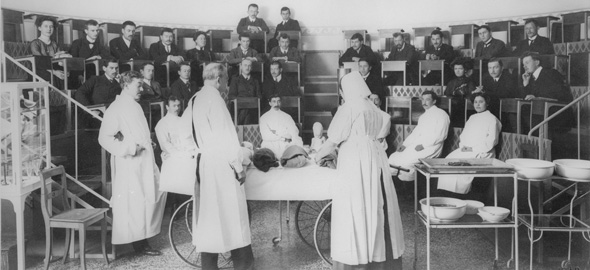Consolidation on the margins: the 1920s to the 1940s
During the interwar period, women’s education became a marginal phenomenon, statistically speaking. Although women gained legal access to higher education, educational paths remained gender-specific. The economic and intellectual crisis of the 1930s, in particular, worsened study and career opportunities for women.
After the pioneering peak of women’s education ended with the First World War, the number of women students at universities stabilized during the interwar period. This consolidation occurred at a low level: the national proportion of women students in Switzerland fell from nearly 25 percent before 1914 to around 12 percent in 1920. While the proportion rose slowly but steadily in the 1920s, it stagnated in the 1930s and 1940s at around 15 percent – and even declined.
This statistical reversal after 1930 is connected to the overall political climate shift, evident, for instance, in the political activities of women’s associations. In the 1920s, a host of women’s associations cultivated a public presence that was self-confident, with clear demands. At the Swiss Exhibition for Women’s Work (Schweizerische Ausstellung für Frauenarbeit, Saffa) in 1928, such groups showcased the significant yet largely invisible contribution of women to the national economic wealth. In the largest petition Switzerland had ever seen, they demanded women’s voting and election rights in 1929.
Faced with the economic and intellectual crisis that soon arrived, their approach became more defensive in the 1930s. Emancipatory women’s interests, such as economic and political equality, took a back seat, and the political goal of “defending democracy” gained importance. In 1933, a large number of women’s associations founded the working group “Woman and Democracy.” In the wake of a hardening climate of national unity calling for “national spiritual defense,” proposals that focused on change lost support. Under pressure to stand united within the “people’s community” (the “Volksgemeinschaft”) and to reaffirm the age-old “distinctiveness” of Switzerland, progressive demands seemed more outlandish than ever.
Burden of proof and fear of competition
In 1924, women graduates established the Swiss Association of University Women (Schweizerischer Verband der Akademikerinnen, SVA). In a study conducted in 1928, the association assessed that women’s education had become a “completely normal matter.” This is quite remarkable, considering the tiny proportion of women – some 15 percent of students. However, this judgment was not primarily focused on the principle of equality but on national and historical perspectives. First, it was noted that Swiss women made up the clear majority of women students, accounting for two-thirds. This was a reversal from the time before the First World War. Second, the authors found the university educational path for the younger generation quite accessible, comparing it to the challenging path facing earlier women pioneers in education, which had required “a maximum level of mental and intellectual resilience.”
The “pioneering work” that “still” needed to be done, the association wrote, concerned the uncertain academic, scientific, and professional prospects for women students. Although the prejudice about women’s intellectual suitability for academic work had been disproved by “proof of competence” through women’s success in exams, the study noted, “doubts have been raised a level higher and are now aimed at women’s performance in research.” “Counterevidence” to this claim, the report noted, was still lacking. That the authors unquestionably accepted the burden of proof as theirs shows that women’s participation in higher education and science was far from being considered a given.
The association considered the chances of women securing extremely scarce positions in the academic professions to be insufficient. The proportion of women was far too low, it observed: among the 3,300 practicing doctors, for instance, only 128 were women. The “male fear of competition” was a “premature worry.”
In the economic crisis of the 1930s, the situation for women in the job market deteriorated significantly. With the rise in unemployment, a spiteful campaign was launched against “double earners,” as they were called: married, working women were expected to give up their jobs in favor of unemployed men and return to their “natural” role as housewives and mothers. When it came to public employees such as teachers and civil servants, this demand was legally enforced at times – women were dismissed upon marriage. Women students were also perceived as future “double earners.” The association, for example, had to fight against the Swiss Pharmacists Association to ensure women were not excluded from pharmaceutical studies.
The campaign reinforced male privilege in the labor market and solidified the association of women with the domestic sphere, further promoting the social generalization of the breadwinner-housewife model that originated with the bourgeois family. Echoing arguments made by the association in 1928, Helene Thalmann-Antenen pointed in 1950 to the “surprising contrast” between the legal right of access to higher education and the persistent lack of career opportunities for female academics.
Distinct educational paths
Since the late nineteenth century, women were allowed to study and take exams at multiple Swiss universities. Yet the formal equalization of educational rights did not eliminate disparities in educational content. Well into the late twentieth century, the idea persisted that education for women and men should be equal in value but not identical in nature.
Instruction in public schools was gender specific, with different curricula preparing boys and girls for their respective social roles. In Basel, the Höhere Töchterschule or “Higher Girls’ School,” which added a high school in 1913, was the primary preparatory institution for women’s higher education. The widely accepted purpose of this institution was to prepare girls for their “true” careers as caring mothers, efficient housewives, and engaging wives.
Girls at the high school, for instance, had to complete a period of agricultural service. In the 1930s, a mandatory home economics course – the so-called “Rüebli-RS,” roughly in English: “carrot boot camp” – was introduced for girls studying at the high school level across Switzerland. This mandate continued until the late 1980s. Gender segregation in school classes was ended in Basel at the end of the 1950s.



